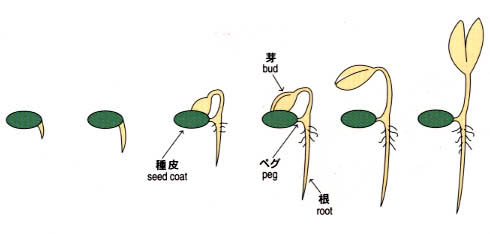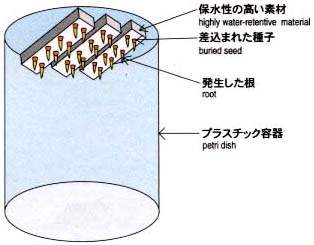| Principal Investigator |
: |
 |
Hideyuki Takahashi, Ph.D.
(Tohoku University) |
|
| Objective |
: |
Small protuberance called "peg" appear at the transition
zone between stem and root of cucumber seedling immediately after germination.
By hooking the peg to the seed coat, the cucumber seedling peels away the
seed coat.
Since the peg always develops on the lower side of the horizontally positioned
seedling, gravity is likely to play a role in its formation of the "peg."
The experiment aims to observe the formation and positioning of the peg
under the zero-gravity condition.
|
| Experiment outline |
: |
Cucumber seeds are germinated under the zero-gravity condition to observe
the peg formation.
The bottom of a plastic container is covered with a highly water-retentive
material, and cucumber seeds are buried and fixed in the material. Once
this seed bed is carried to outer space, water is fed to the seeds to induce
germination. The state of growth of the cucumber is observed, and the seedlings
are chemically fixed for the analysis of various biological parameters.
|
 |
| The cucumber form "peg" during germination. By the peg, the
cucumber seedling peels away the seed coat. |
|
| Experimental unit |
: |
Biological Research in Canisters (BRIC)
 |
| In this experiment ,two petri dishes will be stored
in a BRIC. |
|
| Expected effects |
: |
The experiment will clarify the role of gravity in the peg-formation
of cucurbitaceous plants such as cucumbers. It will also enable further
study on the mechanism of peg formation as well as the formulation of a
new experimental model to understand the relation between plants and gravity.
These studies will also help to understand why only the cucurbitaceous
plants form peg, and how the Earth's gravity affects the evolution of plants.
The findings should provide fundamental knowledge for growing plants in
outer space in the future. |
